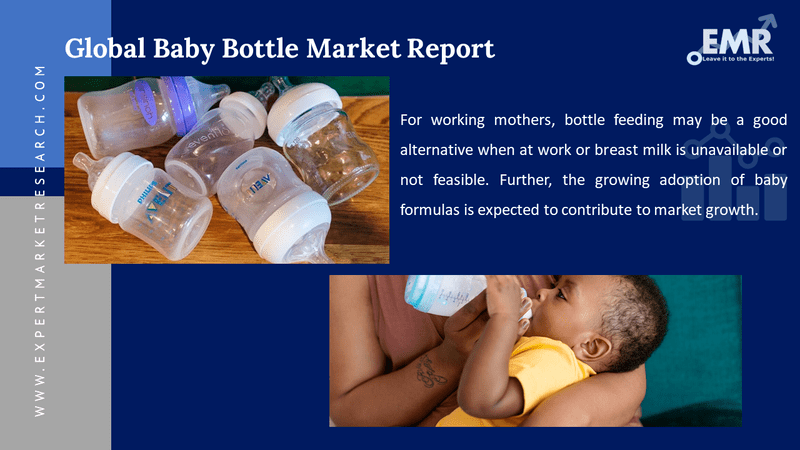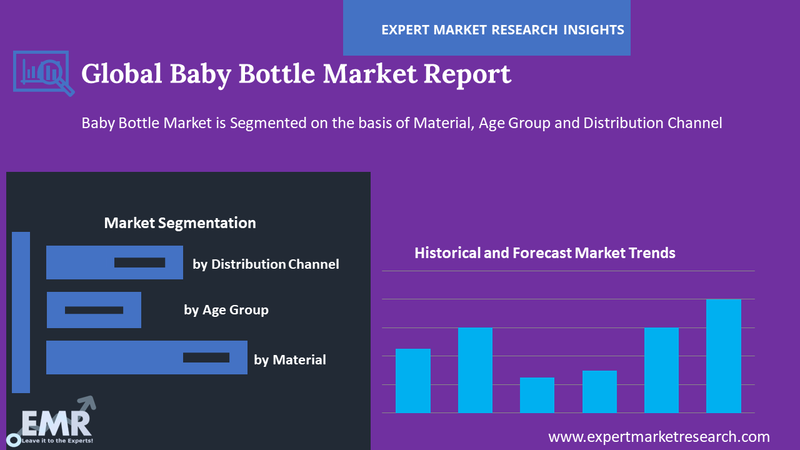
Consumer Insights
Uncover trends and behaviors shaping consumer choices today
Procurement Insights
Optimize your sourcing strategy with key market data
Industry Stats
Stay ahead with the latest trends and market analysis.
The global baby bottle market value is expected to grow at a CAGR of 6.40% from 2026-2035.
Base Year
Historical Period
Forecast Period
Compound Annual Growth Rate
6.4%
2026-2035
*this image is indicative*
| Global Baby Bottle Market Report Summary | Description | Value |
| Base Year | USD Million | 2025 |
| Historical Period | USD Million | 2019-2025 |
| Forecast Period | USD Million | 2026-2035 |
| Market Size 2025 | USD Million | XX |
| Market Size 2035 | USD Million | XX |
| CAGR 2019-2025 | Percentage | XX% |
| CAGR 2026-2035 | Percentage | 6.40% |
| CAGR 2026-2035 - Market by Region | Asia Pacific | 7.3% |
| CAGR 2026-2035 - Market by Country | India | 7.6% |
| CAGR 2026-2035 - Market by Country | Canada | 6.6% |
| CAGR 2026-2035 - Market by Age Group | 6-18 Months | 6.8% |
| CAGR 2026-2035 - Market by Distribution Channel | Online | 10.3% |
| Market Share by Country 2025 | Brazil | 2.6% |

Read more about this report - REQUEST FREE SAMPLE COPY IN PDF
Baby bottles may be made of plastic, glass, silicone, and stainless steel. Plastic bottles are breakproof and lightweight. While modern plastic bottles are considered relatively safe, versions of older bottles carry bisphenol A (BPA), a substance banned by the Food and Drug Administration (FDA) in baby bottles.
Baby bottles offer convenience for flexible feeding, accurate measurement, and controlled milk flow. They are easy to use and clean, allow feeding in public, and enable shared feeding. They help avoid nipple confusion, control temperature, and offer various designs for different needs further boosting the demand of the baby bottle market.
The growing adoption of baby formulas is expected to contribute to the baby bottle industry growth. Baby formulas are very useful when the mother is not producing enough milk for the baby; in such cases, the formula provides the baby with essential nutrients.
The baby bottle market trends and dynamics are being boosted due to the variety of bottle shapes available, including straight, wide, and angled designs that help reduce air intake and improve feeding.
According to the Australian Bureau of Statistics, in 2022, New South Wales registered 95,758 births. Victoria followed closely with 76,187 births, while Queensland recorded 62,313 births. Moreover, South Australia and Western Australia had 19,502 and 31,474 births respectively. Tasmania registered 5,498 births, and the Northern Territory had 3,577 births, showing relatively smaller birth counts in these territories. In 2022, the Australian Capital Territory reported 6,375 births, showing a consistent trend. Across Australia, there were 300,684 births, which led to a rise in baby bottle market revenue as the increasing number of live births drives higher demand for feeding bottles.
The growth of the baby bottle market in India is bolstered due to the high live birth rate. The National Family Health Survey for 2023-2024 reports Uttar Pradesh leading with approximately 3,171,580 live births, reflecting its large population and elevated crude birth rate (CBR). Bihar came close behind with 3,150,970 live births, driven by a high CBR of 24.7. Significant figures were also recorded in Maharashtra and Madhya Pradesh, with 1,904,310 and 2,101,040 live births respectively. Tamil Nadu, with a CBR of 13.9, estimated 1,064,360 live births. Rajasthan and West Bengal had 1,916,800 and 1,450,700 live births respectively. Smaller states such as Arunachal Pradesh and Sikkim had lower estimates, with 27,140 and 7,130 live births respectively. Kerala, noted for its lower birth rate (CBR of 13.2), estimated 517,870 live births. Gujarat reported 1,389,750 live births, reflecting moderate population growth with a CBR of 19.8.
The European E-commerce Report 2023 indicated that in Europe, 67% of internet users shopped online in 2018. This number rose to 70% in 2019 and further to 74% in 2020. By 2021, e-shoppers had increased to 75%, reflecting a growing trend in online purchasing. This percentage rose to 76% in 2022 and further to 78% in 2023, boosting the baby bottle industry revenue as consumers increasingly choose the convenience of online shopping for baby products.
In 2022, data from the National Bureau of Statistics of China shows that online retail sales of physical goods saw a strong growth rate of 6.2%. Convenience stores followed with a 3.7% increase, while professional stores grew by 3.5%. Supermarkets experienced a 3.0% rise, and speciality stores had a slight growth of 0.2%.

Read more about this report - REQUEST FREE SAMPLE COPY IN PDF
“Global Baby Bottle Market Report and Forecast 2026-2035” offers a detailed analysis of the market based on the following segments:
Market Breakup by Material
Market Breakup by Age Group
Market Breakup by Distribution Channel
Market Breakup by Region
| CAGR 2026-2035 - Market by | Country |
| India | 7.6% |
| Canada | 6.6% |
| Mexico | 6.4% |
| Australia | 5.6% |
| France | 5.4% |
| USA | XX% |
| UK | XX% |
| Germany | XX% |
| Italy | XX% |
| China | XX% |
| Japan | 5.0% |
| Saudi Arabia | XX% |
| Brazil | XX% |
Baby bottles for 0-6 months feature anti-colic designs and breastfeeding-like nipples to ease the transition from breast to bottle and offer convenience with easy-to-clean, spill-proof features. Bottles for 6-18 months support the move to sippy cups with spill-proof spouts and handles, providing durability and accommodating higher liquid intake as the baby grows boosting the growth of the baby bottle industry.
The companies specialise in baby care products such as bottles, nipples, and skincare. They are known for its emphasis on safety and innovation, and it provides high-quality, ergonomic items designed to enhance infant health and comfort.




*While we strive to always give you current and accurate information, the numbers depicted on the website are indicative and may differ from the actual numbers in the main report. At Expert Market Research, we aim to bring you the latest insights and trends in the market. Using our analyses and forecasts, stakeholders can understand the market dynamics, navigate challenges, and capitalize on opportunities to make data-driven strategic decisions.*
Get in touch with us for a customized solution tailored to your unique requirements and save upto 35%!
The global baby bottle market value is projected to grow at a CAGR of 6.40% between 2026 and 2035.
The major drivers of the market include the hectic working hours, rising disposable income, increasing penetration of hypermarket and supermarket, drug and pharmacy stores, and online platforms, growing awareness about infant formula, and increasing penetration of innovative products.
Growing adoption of baby formulas and increasing number of working mothers are the key industry trends propelling the market's growth.
The market is broken down into North America, Europe, Asia Pacific, Latin America, the Middle East, and Africa.
The various materials include plastic, stainless steel, glass, and silicone, among others.
Based on age group, the market is divided into 0-6 months and 6-18 months, among others.
The distribution channels of the market are offline and online.
The competitive landscape consists of Pigeon Corporation, Summer Infant, Inc., Medela, Inc., Artsana S.p.A, Munchkin, Inc., Handi-Craft Company, Zhejiang Reshine Babycare Co., Ltd., and Babisil International Ltd., among others.
Explore our key highlights of the report and gain a concise overview of key findings, trends, and actionable insights that will empower your strategic decisions.
| REPORT FEATURES | DETAILS |
| Base Year | 2025 |
| Historical Period | 2019-2025 |
| Forecast Period | 2026-2035 |
| Scope of the Report |
Historical and Forecast Trends, Industry Drivers and Constraints, Historical and Forecast Market Analysis by Segment:
|
| Breakup by Material |
|
| Breakup by Age Group |
|
| Breakup by Distribution Channel |
|
| Breakup by Region |
|
| Market Dynamics |
|
| Competitive Landscape |
|
| Companies Covered |
|
| Report Price and Purchase Option | Explore our purchase options that are best suited to your resources and industry needs. |
| Delivery Format | Delivered as an attached PDF and Excel through email, with an option of receiving an editable PPT, according to the purchase option. |
Datasheet
One User
USD 2,499
USD 2,249
tax inclusive*
Single User License
One User
USD 3,999
USD 3,599
tax inclusive*
Five User License
Five User
USD 4,999
USD 4,249
tax inclusive*
Corporate License
Unlimited Users
USD 5,999
USD 5,099
tax inclusive*
*Please note that the prices mentioned below are starting prices for each bundle type. Kindly contact our team for further details.*
Flash Bundle
Small Business Bundle
Growth Bundle
Enterprise Bundle
*Please note that the prices mentioned below are starting prices for each bundle type. Kindly contact our team for further details.*
Flash Bundle
Number of Reports: 3
20%
tax inclusive*
Small Business Bundle
Number of Reports: 5
25%
tax inclusive*
Growth Bundle
Number of Reports: 8
30%
tax inclusive*
Enterprise Bundle
Number of Reports: 10
35%
tax inclusive*
How To Order

Select License Type
Choose the right license for your needs and access rights.

Click on ‘Buy Now’
Add the report to your cart with one click and proceed to register.

Select Mode of Payment
Choose a payment option for a secure checkout. You will be redirected accordingly.
Gain insights to stay ahead and seize opportunities.

Get insights & trends for a competitive edge.

Track prices with detailed trend reports.

Analyse trade data for supply chain insights.

Leverage cost reports for smart savings

Enhance supply chain with partnerships.

Connect For More Information
Our expert team of analysts will offer full support and resolve any queries regarding the report, before and after the purchase.
Our expert team of analysts will offer full support and resolve any queries regarding the report, before and after the purchase.
We employ meticulous research methods, blending advanced analytics and expert insights to deliver accurate, actionable industry intelligence, staying ahead of competitors.
Our skilled analysts offer unparalleled competitive advantage with detailed insights on current and emerging markets, ensuring your strategic edge.
We offer an in-depth yet simplified presentation of industry insights and analysis to meet your specific requirements effectively.
Share